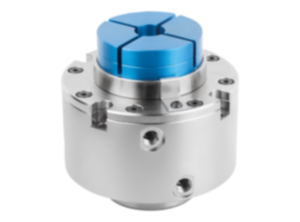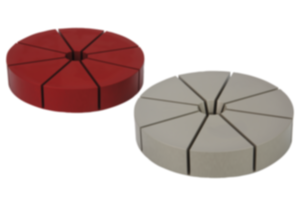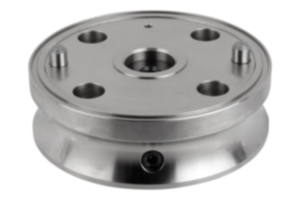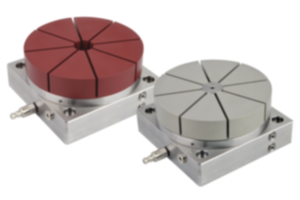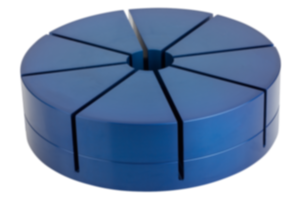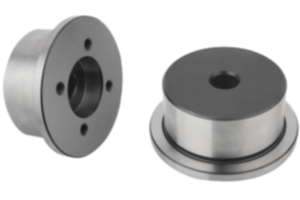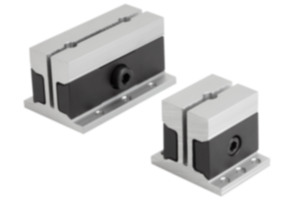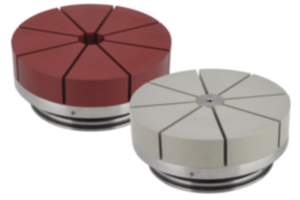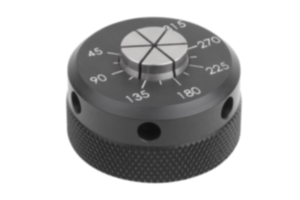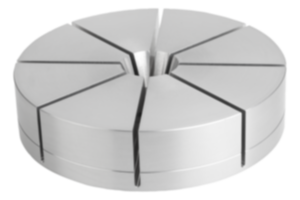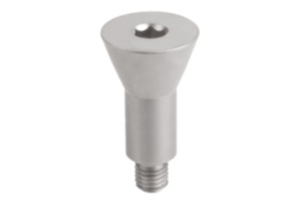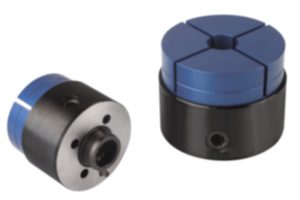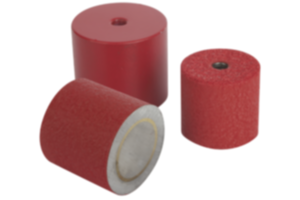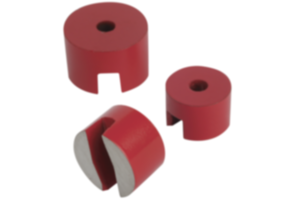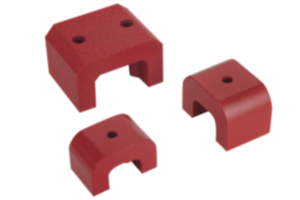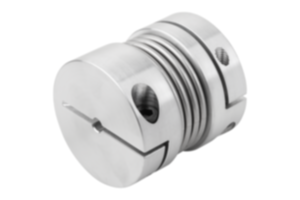Fjädrande tryckstycken, inställningsbultar, kulspärrbultar, spärreglar
Spring plungers, indexing plungers, ball lock pins from KIPP
The product group "Spring plungers, indexing plungers, ball lock pins" from KIPP is divided into the following six categories:
- Spring plungers
- Indexing plungers
- Cam-action indexing plunger
- Ball lock pins
- Locking pins
- Retaining cables, ball chains
Spring plungers
Spring plungers are machine components that have elastic properties. They also have clamping properties for arresting and engaging assemblies.
This is why spring plungers are used in many different applications, e.g. in the automotive industry, machine construction and electronics. They are used to exert a constant pressure on a component in order to hold it in place or move it. They can also be used to dampen vibrations or oscillations and extend the service life of the component.
The pressure is applied by a spring enclosed in a sleeve. This spring acts on a ball or a thrust pin.
To cover a wide range of applications, KIPP offers spring plungers in various materials. In many versions however, the entire product is not made from the same material. The sleeve and ball or pin are made of different materials.
The KIPP range includes the following products:
Spring plungers made from plastic: Plastic is inexpensive and very lightweight. The corrosion resistance of plastic make these spring plungers suitable for outdoor applications.
Spring plungers made from steel: If the sleeve or ball is made of steel, the plungers can withstand high loads and harsh conditions. Steel is temperature resistant and very robust
Spring plungers made from stainless steel: As with the steel spring plungers, the stainless steel parts are also temperature resistant, but are also corrosion resistant. Stainless steel is lighter than steel.
Spring plungers made from ceramic: Only the balls of the plunger are ceramic. Ceramic is resistant to chemicals and is also temperature resistant. We recommend this variant for applications with high cycle rates, as spring plungers made of ceramic exhibit very little wear.
Indexing plungers
Moving workpieces and components can be adjusted quickly and easily using indexing plungers. Indexing plungers are used in a wide variety of areas and enable securing and engagement in assemblies.
Indexing plungers prevent component position changes due to lateral forces. The component can be adjusted by retracting the pin. To retract the pin, the head of the indexing plunger must be pulled up. When the head is released, the pin extends again. The component that was being indexed is now engaged. This is why they are called indexing plungers.
In addition to the standard indexing plungers, the range also includes indexing plungers with a lock function. This type of indexing plunger differs fundamentally from the standard plunger. A button in or on the head must be pressed to engage or disengage the locking mechanism.
Indexing plungers with cam levers work according to the same principle. The difference is that the knob here is an cam lever, which enables operation with just one finger.
KIPP also has the appropriate product in its range if the plunger needs to be operated remotely. Indexing plungers with remote actuation are suitable if there is a lack of space or if the user has to keep a distance from the components for safety reasons.
Indexing plungers can be integrated into automated production processes by using pneumatic indexing plungers. The pins are operated by compressed air and not by hand as with the other indexing plungers in the range.
Thanks to the different versions and materials, the indexing plungers can be used in areas such as machine and fixture construction, the foodstuff industry, automotive engineering and even in the rehabilitation sector for e.g. wheelchairs.
Cam-action indexing plunger
With 2880 items, this product family is the largest in KIPP's main operating and standard parts group "Spring plungers, indexing plungers, ball lock pins".
The product family includes the following locking devices:
- Cam-action indexing plungers, stainless steel cam-action indexing plungers with or without stop
- brackets and aluminium brackets
- barrel slide bolts
- barrel locks made from steel, brass or stainless steel with return spring
- catch plates made from steel, brass or aluminium
- barrel locks with return spring and bevel facing up or down
Ball lock pins
Ball lock pins consist of three main components:
- a grip with push button
- a pin
- balls
Ball lock pins enable two workpieces to be secured and interlocked. Similar to indexing plungers, ball lock pins are unlocked by pressing a button.
When the button is pressed, the balls at the lower end of the pin disengage and the ball lock pin can be inserted or removed accordingly. When the button is released, the balls move out of their openings and thus create an engagement through tension.
Ball lock pins are used in the chemical and foodstuff industries, but also find use in the aerospace industry. Due to the diverse versions, ball lock pins can also be used in other sectors.
The KIPP range includes two types. Both types have stainless steel pins. The standard version is stainless steel 1.4305, the alternative is stainless steel 1.4542
Depending on where it is to be used, the grip material and shape should be selected to suit everyday use.
- Very small grips are ideal where space is limited, large grips when working with gloves.
- The grip material is plastic or die-cast zinc. Plastic grips have a low weight, die-cast zinc grips have high temperature resistance.
Locking pins
Locking pins are a type of pin used to join parts. They are often used in mechanical engineering to affix and secure parts.
Locking pins consist of a head and a shaft. The head is mostly, but not always shaped so that it easy to grip.
Most types have a pin with spring-load balls. these produce the locking effect. When the pin is pushed through the hole, the balls spring out and prevent the pin falling out again.
This ensures that the parts are securely joined together.
The KIPP range includes the following locking pins:
- Locking pins
- Locking pins with key ring
- Locking pins with folding latch
- Locking pins with axial lock
- Locking pins with magnet axial lock
It should be noted that the locking pin with folding latch secures the connected parts via a swivelling flat plate and can also be loaded in the axial direction. This type of locking pin is not only used to secure parts quickly and easily, but also to permanently connect moving workpieces.
Retaining cables, ball chains
These product families contain suitable retaining elements for the indexing plungers, ball lock pins and locking pins.
Key rings: are accessories for retaining cables with eyelets, indexing plungers, ball lock pins and locking pins
Safety spiral cable: The spiral cable is very elastic and has a good restoring properties. It is used to secure fixture parts.
Retaining cables: The retaining cable can be used up to a temperature of 80 °C. In combination with a key ring, the retaining cable prevents any type of pin from getting lost.
Ball chains: Ball chains are made of stainless steel and in conjunction with key rings also secure small parts such as pins.
Ball lock pins
Ball lock pins consist of three main components:
- a grip with push button
- a pin
- balls
Ball lock pins enable two workpieces to be secured and interlocked. Similar to indexing plungers, ball lock pins are unlocked by pressing a button.
When the button is pressed, the balls at the lower end of the pin disengage and the ball lock pin can be inserted or removed accordingly. When the button is released, the balls move out of their openings and thus create an engagement through tension.
Ball lock pins are used in the chemical and foodstuff industries, but also find use in the aerospace industry. Due to the diverse versions, ball lock pins can also be used in other sectors.
The KIPP range includes two types. Both types have stainless steel pins. The standard version is stainless steel 1.4305, the alternative is stainless steel 1.4542
Depending on where it is to be used, the grip material and shape should be selected to suit everyday use.
- Very small grips are ideal where space is limited, large grips when working with gloves.
- The grip material is plastic or die-cast zinc. Plastic grips have a low weight, die-cast zinc grips have high temperature resistance.
Locking pins
Locking pins are a type of pin used to join parts. They are often used in mechanical engineering to affix and secure parts.
Locking pins consist of a head and a shaft. The head is mostly, but not always shaped so that it easy to grip.
Most types have a pin with spring-load balls. these produce the locking effect. When the pin is pushed through the hole, the balls spring out and prevent the pin falling out again.
This ensures that the parts are securely joined together.
The KIPP range includes the following locking pins:
- Locking pins
- Locking pins with key ring
- Locking pins with folding latch
- Locking pins with axial lock
- Locking pins with magnet axial lock
It should be noted that the locking pin with folding latch secures the connected parts via a swivelling flat plate and can also be loaded in the axial direction. This type of locking pin is not only used to secure parts quickly and easily, but also to permanently connect moving workpieces.
Retaining cables, ball chains
These product families contain suitable retaining elements for the indexing plungers, ball lock pins and locking pins.
Key rings: are accessories for retaining cables with eyelets, indexing plungers, ball lock pins and locking pins
Safety spiral cable: The spiral cable is very elastic and has a good restoring properties. It is used to secure fixture parts.
Retaining cables: The retaining cable can be used up to a temperature of 80 °C. In combination with a key ring, the retaining cable prevents any type of pin from getting lost.
Ball chains: Ball chains are made of stainless steel and in conjunction with key rings also secure small parts such as pins.
